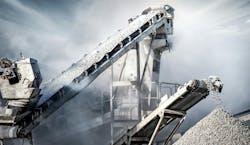How material properties determine the optimal bulk solid conveyor: Part 1
There are many types of conveying systems for transporting powders and bulk solid materials. The material’s characteristics will often determine the best type of conveying system for a given application. Understanding the material’s properties will help processors rule out some conveyors and choose which types will work well.
Particle size and particle size distribution
The desired transfer rate will often determine the size of the conveying system. But if the material has large pieces or chunks, then particle size can dictate equipment openings and sizing since it must be big enough to prevent jamming. Alternatively, fine particles and dust can cause issues with cleanliness, seal and bearing life, and safety. Accordingly, fine particles are a good match for mechanical conveyors only if fully enclosed. Pneumatic conveying is often a better solution for fine particle sizes since the powder is enclosed in a pipe during transfer.
Measuring particle size distribution for conveyor selection is most often done using sieves that sort particles onto screens with various opening sizes. Screens and screen shakers have been around for decades and are the workhorses for many bulk solid applications. They are good for larger particles and for determining the amount of dust in a material. But determining the size of fine particles requires more sophisticated instruments, such as air-jet sieves or laser diffraction. Dustiness, or dispersibility, is the tendency for dust to leave the main pile of material and is measured using instruments such as the Hosokawa PT-X Powder Tester.
Particle shape
Particle shape affects most other properties on this list. In addition, irregular shapes and interlocking pieces will cause jamming, especially if the pieces are large. Conveyors that move through the material, such as screw conveyors, typically don't work well with such materials, and conveyors in which the material lies on the conveyor, such as belt and vibratory conveyors, are often the best option. In contrast, spherical particles tend to roll off belts and vibratory conveyors, so most other options are better for materials with spherical particles.
Particle shape determination is often done visually, comparing particles to a set of standard shapes. Automatic visual and laser options are available for sophisticated measurement.
Explosivity and toxicity
Materials with potentially explosive dust are routinely conveyed using pneumatic conveyors because the equipment is enclosed and practical explosion protection can be added. Even highly explosive dust can be pneumatically conveyed using nitrogen or another inert gas instead of air. Many large systems use mechanical conveying with adequate dust collection for high rates of big particles when some dust is present, such as grain and coal handling. Accordingly, drag conveyors, bucket elevators, belts, and screw conveyors are all good choices if dust collection is incorporated.
If the material is toxic, then containment in a closed-loop pneumatic conveying system may be needed to keep operators and the environment free from contamination.
Part 2 of this article will focus on how a material’s abrasiveness, friability, flowability, and cohesiveness help dictate which type of conveyor is best for an application.
Todd Smith has helped manage Kansas State University's Bulk Solids Technology Center for four years. KSU-BSTC (https://bulk-solids.k-state.edu) is the only university-centered facility and staff in North America dedicated to helping industry with bulk solid challenges and education. Previously, Todd spent his nearly forty-year career in industry working with bulk solids — first at four DuPont plants, then at Mac Equipment (now Schenck Process) and Coperion K-Tron. Todd is also a member of Processing’s editorial advisory board.
About the Author

Todd Smith
Todd Smith has helped manage Kansas State University's Bulk Solids Technology Center since 2019. KSU-BSTC (https://bulk-solids.k-state.edu) is the only university-centered facility and staff in North America dedicated to helping industry with bulk solid challenges and education. Previously, Todd spent his nearly forty-year career in industry working with bulk solids — first at four DuPont plants, then at Mac Equipment (now Schenck Process) and Coperion K-Tron. Todd is also a member of Processing’s editorial advisory board.
